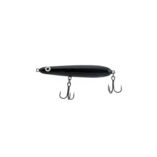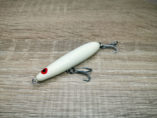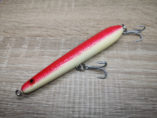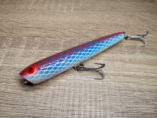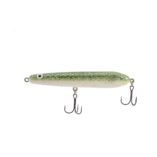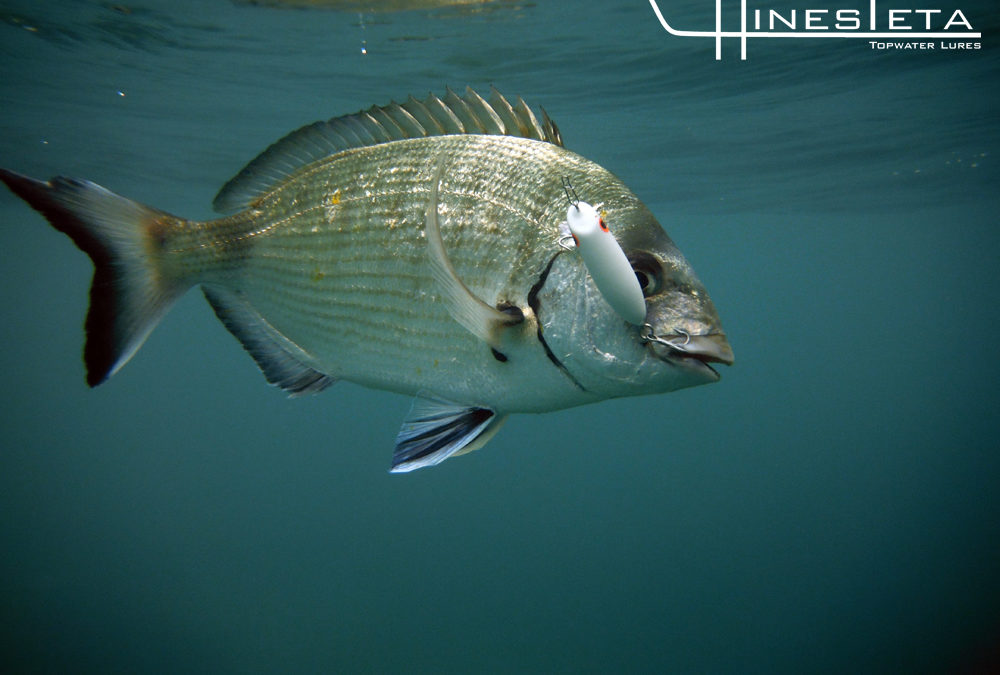
by Jose Chinesta Esteve | Jun 24, 2019 | Uncategorized |
Tired of searching the internet for lures fishing rock fishing and not find them?. In Chinesteta we offer you our handmade lures made of wood for rock fishing. We have 4 different models , with different shapes and characteristics, to offer the fisherman more posibilities in this fishing. We call fishing fishing with very light equipment (action rods 1-7 g and 1000 reels) and we use very light lures, according to the equipment we use. All kinds of species are fished in the sea and minnows and walkers are used to deceive them. Our Chinestetas will offer you a launch far superior to the traditional plastic lures, you will arrive where you have never arrived.
But, before getting into the subject, let’s see a brief introduction on rock fishing, a very funny fishing.
Rock fishing fishing
Rock fishing fishing became popular a few years ago and today it is a type of fishing used by many fishermen and fisherwomen. It is a simple and economic fishing because with little money we can have a good team and with a few lures we can cover all kinds of situations. Now let’s talk about the team, the cane is usually short, 1.8 m and 1-5 g action or 1-7 g, are very light rods and do not tire fishing with them. The reel is in line with the reed and usually uses a 500 or a 1000.
The lures for rock fishing can be made of vinyl or hard material, plastic or wood. We here in Chinesteta Lures manufacture minnows and walkers of linden wood, which is a wood that floats and weighs. With the linden we get some lures with very good movement in the water and that reach a distance much higher than plastic lures. We make 4 different models: the Sorino 50 , the Sorino 60 , the Llobarro 60 and the Killer 60 . All have a very small size 50 or 60 mm and a weight over 6 g. With them you will be able to fish all kinds of species: seabass, bream, pigeon, obladas, needles, groupers, horse mackerel, horse mackerel, etc.
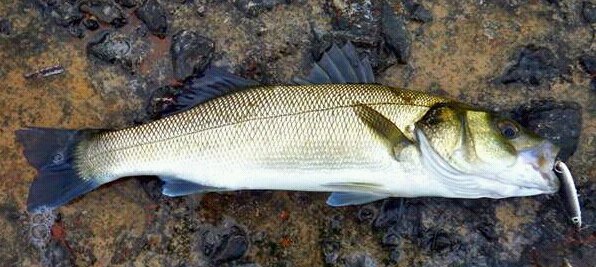
A sea bass, captured with Llobarro 60
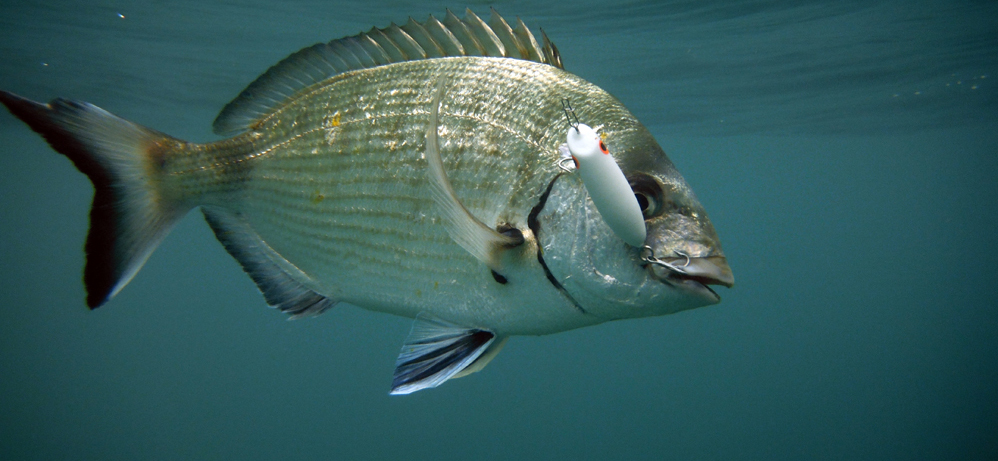 A sea bream, caught with a Sorino 50
A sea bream, caught with a Sorino 50
How to choose the best lure for rock fishing
I think it is necessary to explain the 4 Chinesteta models that we manufacture and their characteristics.
Sorino 50
The Sorino 50 is the smallest Chinesteta lure, but despite this has been a lure that has achieved many captures to rockfishing Exclusively designed for this fishing, it is a small minnow of linden wood, with a different shape to the minnows we know. It has a bevel cut that is the bait of this lure and makes it sink and move waddling about a foot from the surface. It has a size of 50 mm and a weight of 5 g, it is a floating lure.
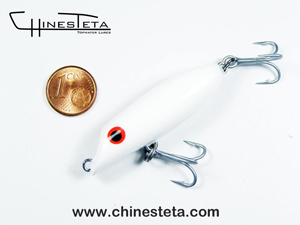
Chinesteta for rock fishing, the Sorino 50
Sorino 60
Our Sorino 60 was the first lure for rock fishing that we made and the one that catches the most, of all our Chinesteta models . Like his little brother, the Sorino 50, is a floating minnow with a bevelled head that causes it to sink when it picks up and moves sinuously. It launches very well thanks to being made of solid wood and you will get many captures to rock fishing. It has a measurement of 60 mm and a weight of 6 g.
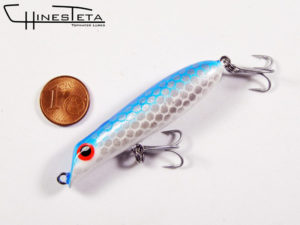
Sorino 60
Llobarro 60
The Llobarro 60 is a smaller walker that we manufacture. It maintains the shape and the leaden of its older brothers, the Llobarro 100 and the Llobarro 120. And above all its best virtue is the distance it reaches when thrown, its aerodynamic shape makes it fly and does not slow down in the air. And then when you fall into the water you can move it in zigzag and give it pauses, since it is a floating walker. Especially suitable with sea bass, in fact has achieved many of them, but valid for all types of rockfishing species. With a size of 60 mm and a weight of 6 g, it will be a fixed in your fishing box.
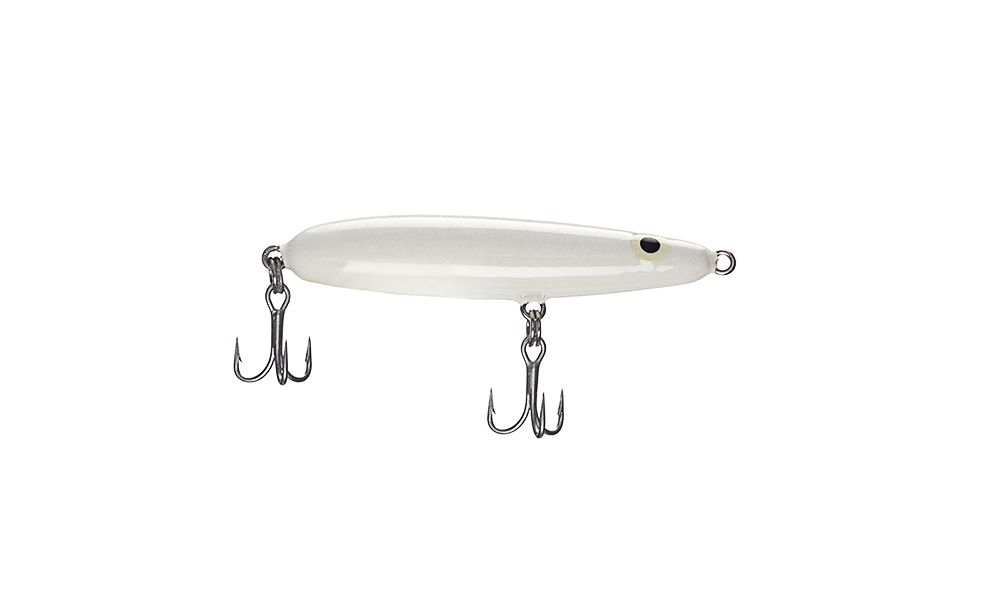 The Llobarro 60 lure for rock fishing
The Llobarro 60 lure for rock fishing
Killer 60
Our Killer 60 is a miniature pencil popper, with the same characteristics but at 60 mm. It is a floating surface lure that has a short movement and can also poppear (spit water) with its mouth. It is very nice to fish with him and you will get many attacks and many catches. If you have sea bass and anchovies in your waters, this is your Chinesteta. It measures 60 mm and weighs 6 g, made of linden wood.
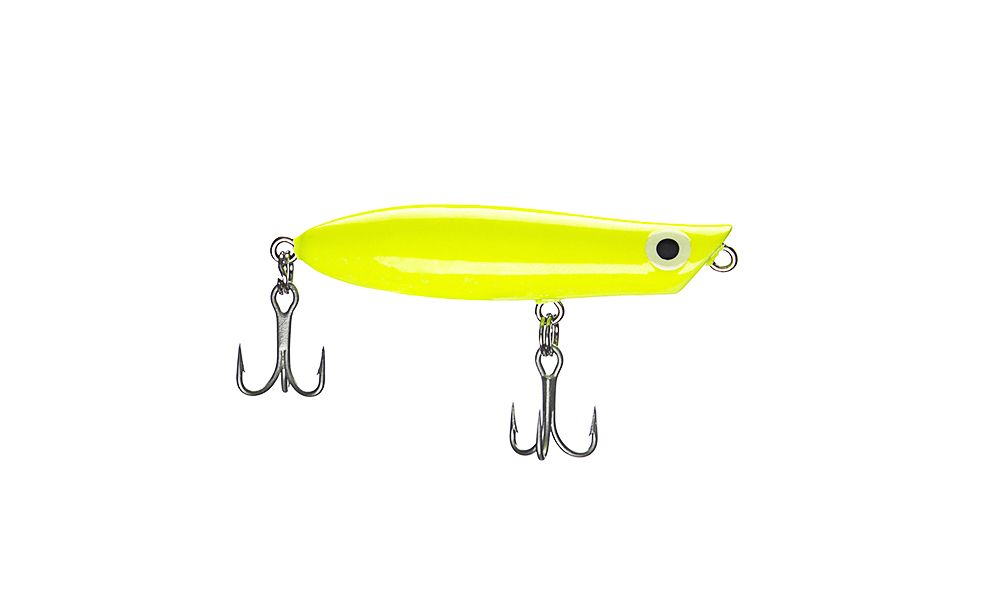 Lure for rock fishing, our Killer 60
Lure for rock fishing, our Killer 60
We’ve already introduced you to our 4 models: Sorino 50 , Sorino 60 , Llobarro 60 and Killer 60 .
We advise you if necessary, choose your chinesteta and fish.

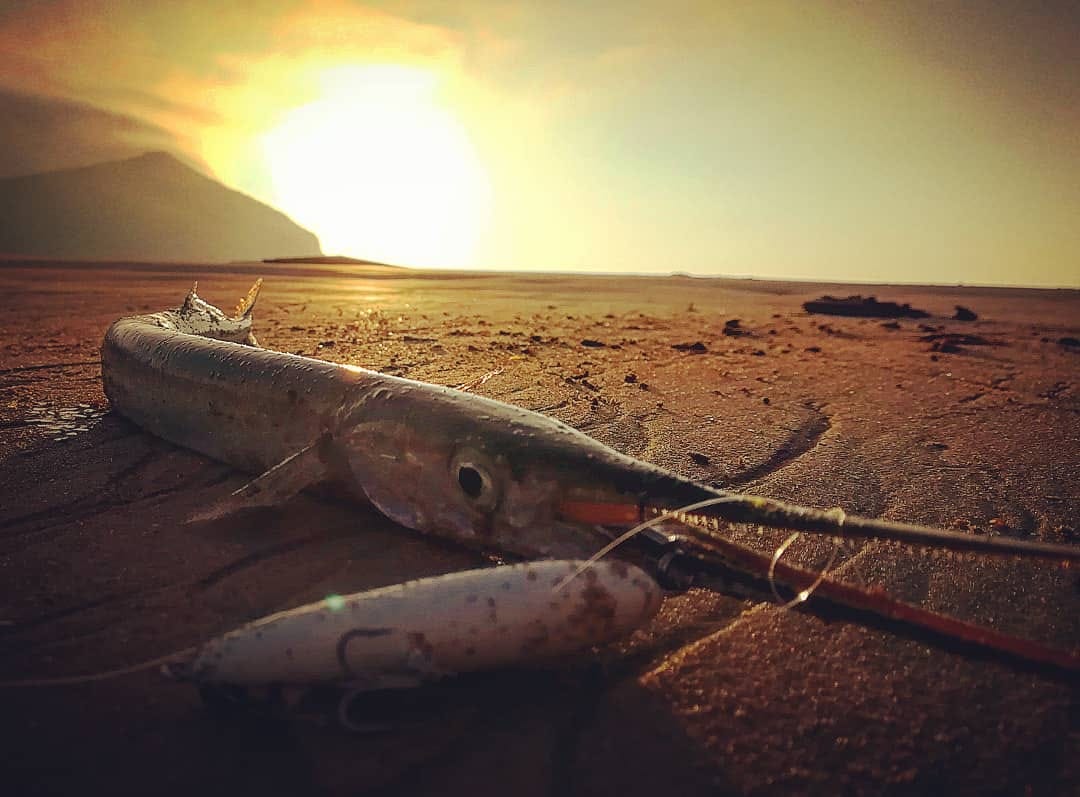 Needle caught with a Llobarro 60
Needle caught with a Llobarro 60
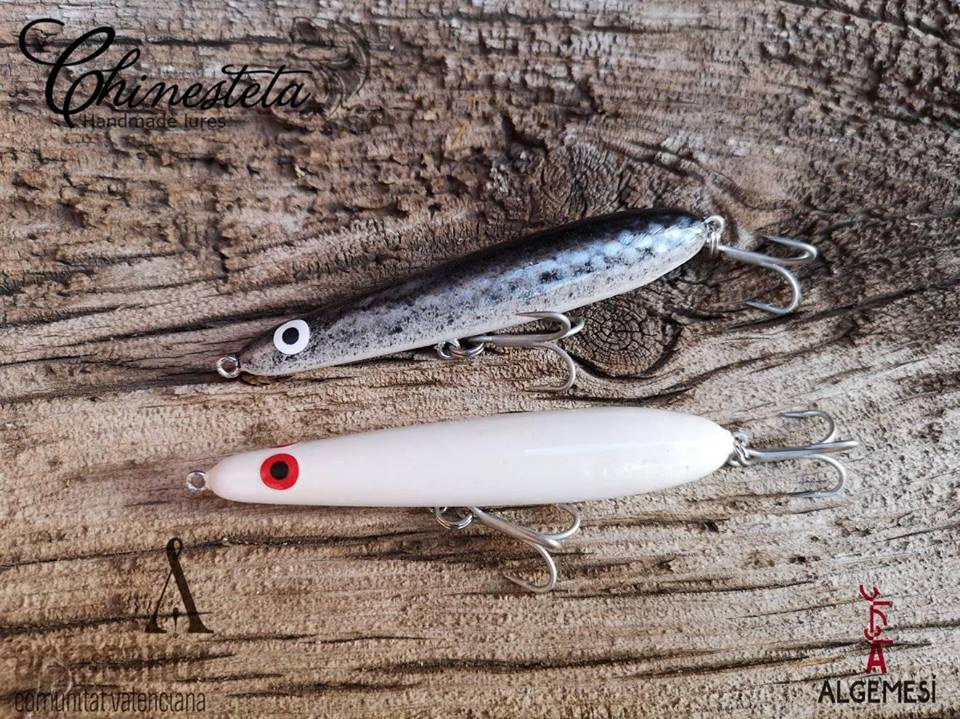 Rock fishing lures
Rock fishing lures
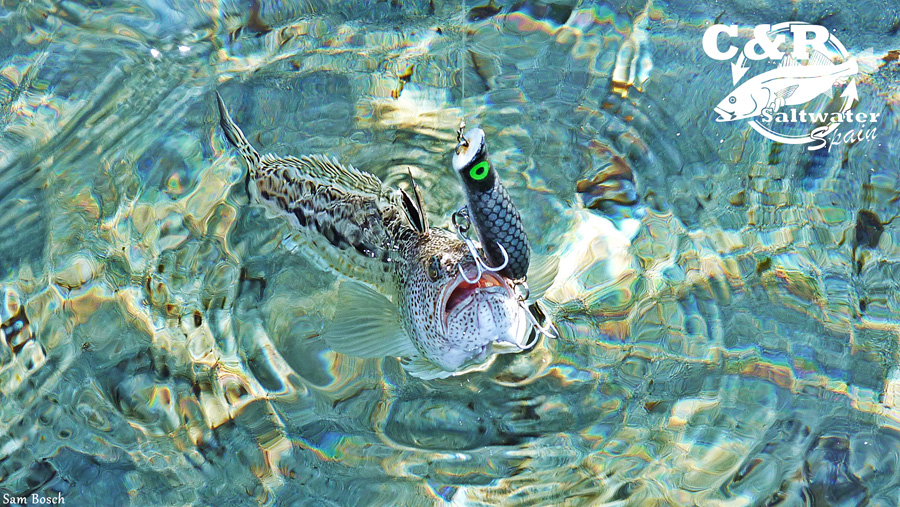
Spider caught with the Killer 60
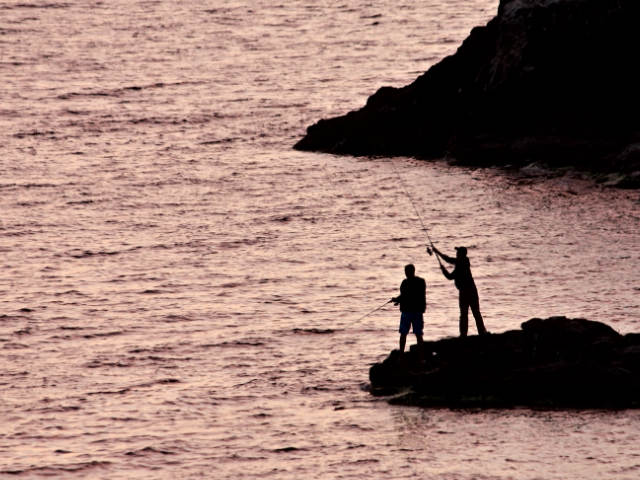
by alfredo | Jun 27, 2017 | Uncategorized |
Are you looking for a good lure for bass fishing? This grayish fish is one of the most desired catches by fishermen around the world. But, when diving into bass fishing, the lure we choose is a big a key to success. At Chinesteta we have vast experience in the manufacture of fishing lures for sea bass, and in this article we’ll go over the main points to consider in choosing a good lure.
But before going into this, let’s have a brief introduction to sea bass, one of the most sought-after catches.
The characteristics of sea bass
Sea bass is a medium to large size fish commonly found throughout the Mediterranean and the Atlantic Ocean, from the African coasts (Senegal) to Norway. They can weigh up to 10kgs, but an average catch is usually just over a kilo (in fact, catching a 4 or 5 kilogram bass would be considered a big success!).

A Bass caught with a Chinesteta fishing lure
This species has a greyish colour, with the belly being pearly white, has a curved shape which is very noticeable for fishermen. Just like black bass, it stands out for its wide mouth, very strong and inclement with its prey. Both fish have very similar habits.
The sea bass is a very coveted fish by fishermen, who seek it out for several reasons. The first is its attractive shape and colours, which clearly differentiate it from other fish. The second is its aggressiveness; it is a voracious fish which attacks its prey in quite a unique manner. All this makes it a very interesting catch. Finally, it is known for its meat, which is very tasty.
Although complicated to fish, in some places the number of sea bass in the water is quite high, mainly because many of them escape from fish farms. When the sea is rough the cages often break and these fish are free, which results in the presence of thousands of sea bass along our shores from fish farms. These seabass which have originally been bred in captivity, are much easier to fish. This is because during the breeding process in the farms, they are fed very frequently to encourage them to grow faster. Once released, they have to be very aggressive to be able to feed at the same pace. This makes them easier for fishermen to catch.
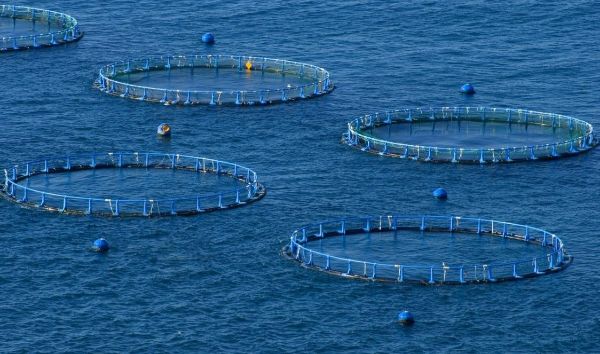
A fish farm in the sea
If these reasons motivate you, and you want to get into a good adventure, one of the first steps to take is to choose good equipment. And the key element here is a suitable lure. To help you in this process, we’ve put together 5 tips for choosing the best lure for bass.
How to Choose the Best Lure for Sea Bass
Casting it far enough
Let’s be clear: wild sea bass do not make it easy for fisherman. Whether they are in salt water or in fresh water, they often choose hidden places to hide, and of course if we wish to catch them we’ll first have to reach them.
In the case of sea fishing, seabass are usually in areas where the waves break, some distance from the coast. If the sea is calm we’ll be able to fish in a boat, but if it’s rough – as it usually is in the Bay of Biscay, for example – we will need a sea bass lure that can be thrown from the shore, and travel as far as possible.
Chinesteta lures are made of wood, which allows them to be cast for up to 40 metres (130ft) farther than other fishing lures. This makes them perfect for reaching those sea bass that appear to be unreachable.
In this regard, a good choice is the Chinesteta Bluefish 125, a piece with an outstanding cast. The Bluefish 125 flies like a bullet and reaches much further than other sea bass lures.
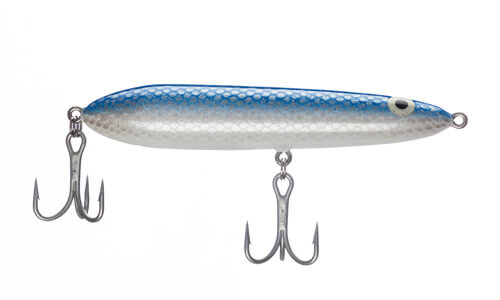
Chinesteta Bluefish 125
Find a sea bass lure to withstand the roughest waters
Sea bass is a fish that usually attacks when there are waves and the water is rough. They go to where the waves break, and take advantage of the foam when hunting their prey. As we mentioned in the previous point, it is imperative that our sea bass lure be cast well and be able to reach into those areas. However, if it does reach, but does not withstand the impact of the waves well when submerging in the water, we will lose everything we have achieved thus far. So, we’ll need a resistant, heavy fishing lure that will withstand the movement of the wildest waters.
At Chinesteta we manufacture very resistant lures. The Seabass 120 is especially suitable. It is of medium size, heavy, and withstand the impact of waves very well.
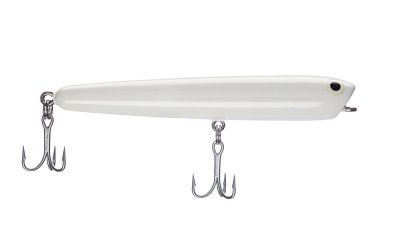
The Sea Bass 120 fishing lure
Avoiding fishing lures with rattles
Basses are extraordinarily cautious fish, who have learned to recognise the rattle of lures and who are not likely to fall for this deception. In addition to living in the sea, in ports, docks, marshes and breakwaters, they also tend to go up rivers to fresh water environments. They use reeds, ships, rocks and the most hidden obstacles along the shore, both to hide and to hunt the unsuspecting small fish that are within their reach.
There are no waves in these areas, so they are much calmer and quieter. We’ll therefore need a fishing lure for quiet bass, with no rattles. so as not to scare these fish away with their sound. None of the Chinesteta lures rattle, making them perfect for fishing for this prey. The bass will be much more trusting of a silent lure, which they will not relate to fishermen.
Find a bass lure that allows you to play around with movement
As in fishing for the vast majority of fish, the movement that your lure allows you to make is key when it comes to catching bass.
With this fish, a zig zag (also called “walking the dog”) is used, which is the most common in attracting them. Depending on the model of lure you use, you can perform this zigzag movement in a wider or shorter manner. Let’s see when it is better to choose one or the other.
- If we see that the bass is aggressive, it will be more effective to make short and fast movements. The fish will more easily detect the lure, and will not hesitate to attack it. The Seabass 120 from Chinesteta is perfect for making these kinds of movements.
- If, on the other hand, we detect that the sea bass are suspicious, we must use a lure that allows us to make larger and slower movements. If the fish are cautious, this slower movement won’t frighten them as much and will give them greater confidence. Do you know which lure to use for this? The Sea Fishing 120 is perfect.
The quality of the hook is important
A good hook is always important when fishing! But with the sea bass this is especially the case. Depending on the type of water in which they are found, our lure must have a good triple.
- When fishing in fresh water, we would do well with a basic hook – always of good quality. The sea bass is an aggressive fish, so we want it to be reinforced so as to handle its bites without bending. The Black Bass 120 from Chinesteta is very suitable for this purpose.
- When fishing in salt water, we must bear in mind that the triple should be salt resistant. Otherwise, it will rust upon contact with water. In the sea it is especially important that the triple of our lure sea bass lure be reinforced. At Chinesteta we work with very high quality hooks, which you can find on many of our models: Seabass 120, Sea Fishing 120, Bluefish 125. All of them have reinforced and saltwater coating triples.
All Chinesteta lures are armed with quality triples approved by fishermen from all over the world. Whether you fish with a Chinesteta lure or with any other brand, always pay attention to the hooks! They can make the difference between getting a catch or not.
Other recommendations for bass fishing
Now that we have already seen the main points to keep an eye on when choosing a bass fishing lure, we will go over a series of general recommendations.
- The lure that we choose is vital, but the rod also plays a fundamental role. It will have to be long enough to support the weight of the chosen lure. For a 100-120mm Chinesteta lure, the ideal rod will be 2.10m long. For heavier bass-fishing lures, we’ll need 2.70m rods. It’s important to choose a rod that has the right action for the lure. Otherwise, we could end up breaking the ring or the tip.
- Like many predators, seabass is a species that is most active in low light conditions, so it will be easier to find them at dawn, dusk and night. It is a good strategy to take advantage of those hours of darkness to tempt them, and catch them.Although it is more common to do so at dawn, there are also fishermen who try their luck at night. They usually go to port or breakwater areas, to take advantage of nearby lights and not be in total darkness. However, there are also fishermen who fish in more hidden places, without lighting. In these areas, sea bass are more confident because they are not so used to fishermen. However, it is dangerous for the fishermen, who may have an accident due to lack of light and not then be able to find help in the vicinity.
- With sea bass fishing, catching and letting go is quite common. This is one of the most important habits among fishermen, who often promote it to avoid the depletion of the fish and to continue fishing sustainably.
Conclusion
As we said before, sea bass is not an easy fish to catch. It is difficult and very cautious, hides and is distrustful of noises. Beginners may find it difficult to find them, or not to scare them. But, like everything else, practice makes perfect. Experience will teach the fisherman where to look for these fish, and how to make the right moves to catch them. For this reason, it will always be essential to have a good rod and a decent sea bass lure.
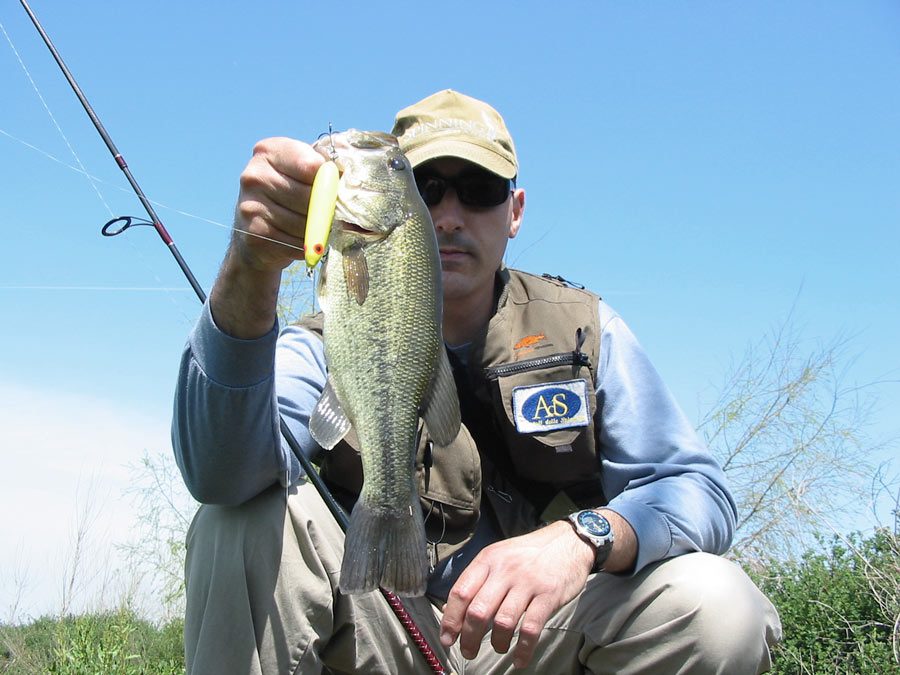
by alfredo | Jun 27, 2017 | Uncategorized |
Are you looking for a good spinning lure? Along with the rod itself and a good reel, this is one of the essential elements when it comes to spinning fishing. Here at Chinesteta we are experts in fishing lures, and in this article we will cover all the factors to be considered when choosing a good spinning lure.
Before getting into the subject, let’s review some key points about spinning: what it is, its most important features and why it is appealing to fishermen
An Introduction to Spinning Fishing
This type of sport fishing basically consists of the casting and reeling in of artificial fishing lures invite the fish to bite. Once in the water, the fisherman has to move the fishing lure in a certain way, imitating an injured fish. If everything goes as planned, the predators will confuse this with a real prey and attack the lure.
However, this is easier said than done since spinning requires some skill, involving plenty of practice to master it completely. The fisherman will have to choose a suitable rod and reel, and must know how to make the necessary movements to deceive the fish.
Ultimately, the movement of the lure is what makes spinning different. In fact, the name comes from the word “spin”, a reference to the movements that are made with the reel handle when we pick up the line.
This type of fishing can be practiced in both freshwater and the sea, and gives us a chance to catch fish of all different types and sizes. We’ll need to choose the appropriate gear for light, medium or heavy spinning, depending on the type of fish we want to catch. Our spinning fishing lure will have to be of the proper weight and size, and the rod action will have to be adapted to that. It is very common for fishermen who are experienced in spinning to have different equipment for each type of catch.
Spinning fishing has been gaining adherents, while the fish themselves have learned to distrust the classic bait and fishermen have been forced to resort to other methods. Spinning lures also offer greater control over the fishing process, and with a little practice it will be the fisherman who are able to provoke the fish’s attack, not having to wait for hours until he chooses to bite (if he chooses to bite!).
Choosing a Good Spinning Lure
Having a good spinning lure is fundamental if we want to get great catches and it’s these artificial fish that make this type of fishing so attractive. Choosing them is not always easy, and it’s important to take several points into account, which we’ll discuss below.
Choose a spinning lure with a good cast
The casting distance is very important if we want to reach the fish. In many cases, predators won’t be that close to us, and will be keep themselves at considerable distances to feed. Therefore, we’ll either have to use a lure that can be cast far enough, or we’ll simply be out of range.
Not all spinning fishing lures you find on the market fly well enough. Many of them don’t have the right weight, and the force of the air is enough to prevent them from reaching the expected distance. At Chinesteta, we manufacture wooden fishing lures by hand, which can withstand harsh wind and can reach up to 40 metres (130ft) farther than a traditional lure. In addition, we weight them individually and by hand, which enables them to travel even longer distances.
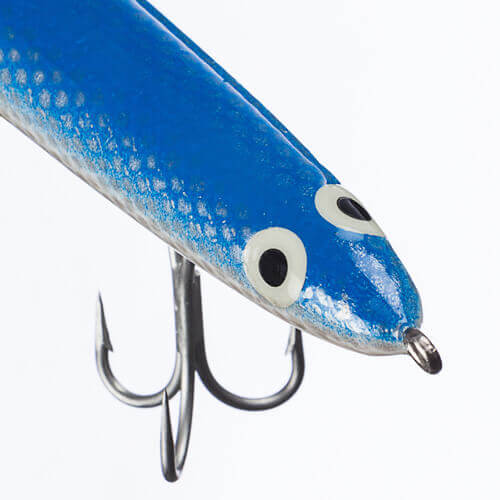
Bluefish 125
The floatation depth of the lure
There is one very important factor with this type of fishing, which is the depth the spinning lures remains at after entering the water. The submersion depth is basically the level of water in which the lure moves around.
Chinesteta Lures are surface lures, meaning they work in this area and do not submerge into deeper layers of water. Being on the surface, the spinning lure is visible all times, and the fisherman can see how it floats and its movement in the water. For fishermen who do spinning it is imperative to be able to see the position of the lure continually. If he can seeing how it moves, it will be much easier to modify its movement and make it more attractive for fish (especially for those fishermen who are beginners, and who have not yet fully mastered the technique).
The use of a surface lure is especially interesting because the predator’s bite is much more spectacular than with a lure that is submerged to a greater depth. This is because, with the lure being in sight, we can see the “explosion” in the water as the lure disappears out of sight. In just a few tenths of a second, our spinning fishing lure will be in the predator’s mouth. We’ll need to take great care to catch the fish and not let it escape!
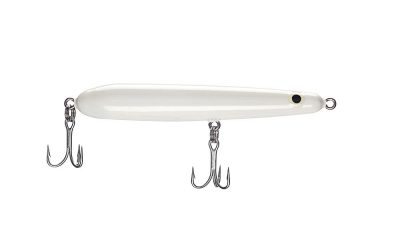
Sea Fishing 100
The fishing lure movement in spinning
Of course the movement of the lure is essential in deceiving the fish. This point is what makes spinning different to other types of fishing, so we should take care in choosing the most suitable fishing lure.
This choice will vary depending on the type of movement we want to create. The most common movements in spinning fishing are as follows:
- Walking: This type of movement consists of short and rapid movements. It is ideal for floating stick baits, but also for sunken stick baits, poppers and pencil poppers.Lure example: Sea Bass 120
- Sliding: In this spinning fishing technique we make long, slow movements, with an open slip and a slow pick up.
Lure example: Sea Fishing 120
- Diving: When making a diving move, the fisherman lets the lure sink, while making downwards motions with the rod. Lure example: Stick 130
- Stop and go: We make successive stops while tugging on the lure.
- Popping: With this movement, we make short movements in order to make the mouth of the spinning lure collide with the water. This “shock” generates a sound, which attracts the fish and improves the chances of their attack. Lure example: Sea Bass 120
- Lineal: A pick up without stops. We cast the lure and pick it up, without making any moves with it. Lure example: Black Bass Propeller 120
Keep in mind the sound that your lure generates
We already introduced this, when we explained popping, but lets return to it now. The sound – or “no sound” – that your lure generates is very important. Our spinning lure may be quiet or produce certain noises when moving underwater. We’ll want to choose one or the other depending on the fish we want to catch, or the state in which these fish are. If the fish are nervous and aggressive, a lure that emits noise will tempt them and will likely make them to bite. If on the other hand, they are suspicious, a silent lure that will not frighten them is more appropriate.
All our Chinesteta models are manufactured without rattles. Predators are already accustomed to this type of noise, and relate them to fishermen. It is quite possible that they’ll swim away as soon as they are heard, and spoil your day of fishing.
Mistakes to avoid with spinning fishing
Not being careful with knots
It is important to tie knots well and check them before each fishing trip, so as to avoid losing the lures when casting. There are several fishing knots for spinning, and we can find many examples of them on the internet.
Disregarding your rod
The spinning lure is a basic item with this form of sport fishing, but we mustn’t forget the importance of a good rod. It will have to be the correct one to support the weight of our lure (they’ll be able to advise us on this in the store).
As we refine our technique and become more involved with fishing, we are likely to invest in more specialised equipment, which will of course be more expensive. Whether we are just starting out or if we are already experienced fishermen, we should always devote a few minutes to cleaning our rod. This process is very simple and helps keep our rod in good condition for much longer. You can do it with water and a brush, with more specialised products (like a silicone spray) or even with homemade mixtures, such as a mixture of water, detergent and vinegar. You can find dozens of tricks and advice from fishermen on the internet.
This point is especially important when fishing in the sea, because the salt can oxidise the rings and cause them to deteriorate in a very short time.
Using low quality rings and triples
Yes, the right triples and rings are very necessary when choosing a good spinning lure. It would not make sense to make an investment in quality equipment while disregarding this point, which is essential in achieving the desired catches. The triples and rings will have to be suitable for the area where we are fishing (sea or fresh water), and we should always check the tips to see that they are sharp and haven’t rusted.
Chinesteta spinning lures are handmade and feature high-quality reinforced triples that resist nitrate and fish bites without bending. It really has to be this way, because a good lure doesn’t make sense without a good hook to go with it.
These are all our tips for those fishermen who are looking for the best spinning lure and who want to get the best catch. Spinning is one of the most popular fishing methods for many different reasons, and more and more fishermen want to “give life” to their lures with various movements and techniques. With practice, good equipment and a lot of willpower, we’ll soon become experts in spinning fishing.

by alfredo | Jun 27, 2017 | Uncategorized |
This year Chinesteta, the artisanal fishing lures manufacturer, has entered into a number of differenent sponsorship deals. It has reached agreements with 11 different organisations, as well as with some national fishing championships.
Naturally, this sponsorship has consisted of providing each with wooden Chinesteta lures. These lures are awarded as prizes in the local and national competitions held by each club.
Here are a few of the organisations Chesteta has had deals with:
- Almeria Spinning
- Minglabass Club
- Club Peskayakisla
- Club de Pesca Motril
- Club Surfcasting Granada
- Club de pesca deportiva Almenara
- Club Bassmaster Alberic
- Club de Pesca Deportiva Alcora
- Kayak Fishing Levante
- Club de Pesca Deportiva Benicarló
Chinesteta sets a benchmark when it comes to handcrafted fishing lures, and these days more and more fishermen are opting for them. They are much more effective than other lures both in salt water and freshwater, thanks to their individualised manufacturing.

 A sea bream, caught with a Sorino 50
A sea bream, caught with a Sorino 50 The Llobarro 60 lure for rock fishing
The Llobarro 60 lure for rock fishing  Lure for rock fishing, our Killer 60
Lure for rock fishing, our Killer 60 
 Needle caught with a Llobarro 60
Needle caught with a Llobarro 60














